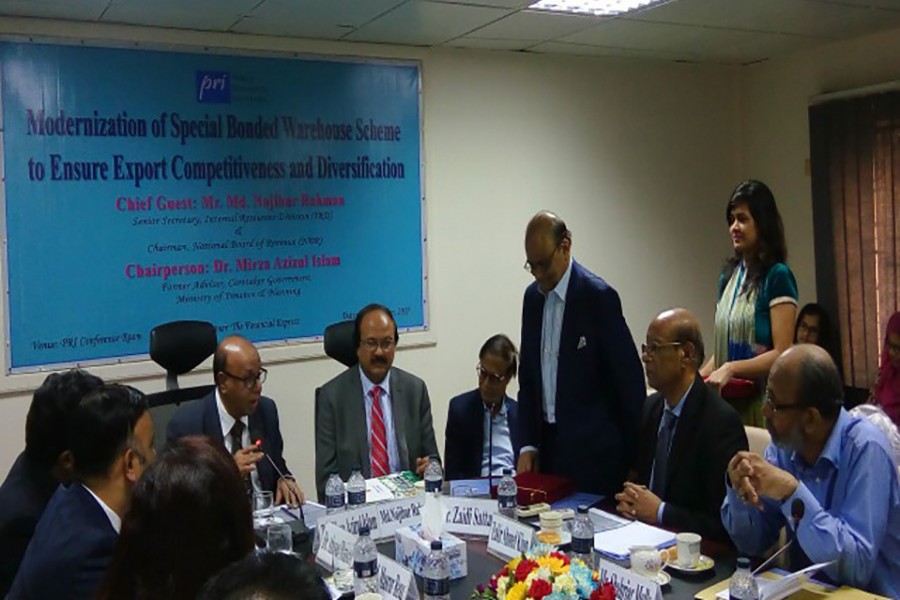Extend bond facility to potential non-RMG sectors too
Economists, businesses recommend as a strategy to diversify exports

Published :
Updated :

Speakers at a roundtable recommended Thursday the government to offer uniform incentives, including the bonded warehouse facility, to the non-readymade garment sector to help diversify export items.
They said that an effective special bonded warehouse (SBW) facility could help boost non-RMG exports by approximately US$ 1.5 billion annually.
They also suggested extending the SBW beyond the 100 per cent export-oriented industries to facilitate enhancing the capacity of the non-RMG sectors.
RMG makes up 82 per cent of the country's export basket, contributing around $28 billion to the country's total export earnings of $35 billion in the fiscal year 2016-17.
Private think-tank Policy Research Institute (PRI) organised the roundtable on 'Modernization of Special Bonded Warehouse Scheme to Ensure Export Competitiveness and Diversification' at its office in the city.
Senior secretary to the Internal Resources Division (IRD) and National Board of Revenue (NBR) chairman Md Nojibur Rahman attended the programme as chief guest.
Former finance advisor of the caretaker government Dr Mirza Azizul Islam chaired the programme. PRI chairman Dr Zaidi Sattar presented a keynote paper on 'SBW, Export Competitiveness and diversification' while executive director Dr Ahsan H Mansur delivered the opening remarks.
Mr Mirza Azizul Islam said that Bangladesh has the second lowest export-GDP ratio among the 12 Asian countries in the world after Pakistan.
"Export-oriented sectors need relatively low and rationally undifferentiated tariff scheme," he said, adding that the SBW should be offered beyond the RMG exporters for export diversification.
In the keynote paper, Dr Sattar said that Bangladeshi exporters needed to import inputs for their industries at 'world prices' under duty-free facility to ensure level-playing field and exploit the opportunity of cheap labour cost.
"There are above 1,400 products in the non-RMG category that were exported in FY2017. They are importing inputs paying 50 per cent duty on an average," he said.
He added that an average export growth from 2001 to 2017 period of RMG products were 20.8 per cent while it was 17 per cent for non-RMG products.
Only footwear and leather goods exports registered an average 21 per cent growth during the period, he said. Non-RMG exports are in a disadvantaged position compared to that of the RMG exports.
Dr Sattar also said the export sector was facing a global competition without tariff protection of the government. However, production for domestic market receives high tariff protection, which raises profitability.
For these reasons, Dr Sattar said, the domestic sales of non-RMG products would be much more profitable than exports, hindering the export-diversification. "Tariff-induced profitability of domestic sales discourages exports."
He indentified three big challenges of export diversification-extension of SBW to all non-RMG exports, not deterring for leakage and abuse of the facility, and modernisation and automation of the SBW.
"Only 2.0 per cent of the SBW may be abused by the vested quarters. For this, 98 per cent of the exporters should not suffer," he said.
In last fiscal year, the RMG sector enjoyed 73.37 per cent of revenue exempted on imports under the SBW. The exemption boosted export and helped the sector growing, he added.
Dr Ahsan said that the export diversification was a challenge for Bangladesh. SBW needs careful consideration for non-RMG exports, he added.
The NBR chairman said that the revenue authority was in the process of automating the SBW facility that has already got approval of the Executive Committee of the National Economic Council (ECNEC).
"Bond was a mystery for me as I have found many abuse of the facility," he added. The NBR was taking effective measures to address the anomalies of the SBW facility through framing new customs act, he added.
NBR member (customs bond and automation) Shahriar Mollah said it was not true that only the RMG exporters were enjoying the bond facility. "There are some 4,909 active bond licences. Of them, 2,847 are RMG exporters and rest 2,062 from non-RMG sector," he said.
It has been found that some 50 per cent of the non-RMG exporters have bond licences, he said. Some 21 home consumption bonded warehouse facilities are also there, he added. None of the customs laws or rules has the provision to offer SBW only for the RMG sector, he added.
PRI director and former finance secretary Zakir Ahmed Khan said that the exporters have to pursue the government with data and information, saying about the facilities they needed to sustain in the competitive market.
Former president of Dhaka Chamber of Commerce and Industry Asif Ibrahim said that the revenue board should frame a standard policy extending same facilities to all the potential export sectors for diversification of exports.
Some non-RMG sectors like pharmaceuticals, leather, jute and home textiles, among others, have huge potentials in the export market, he said, adding that the NBR policies, including the bond facility, were highly biased to the RMG sector.
Representatives from different private sectors also demanded bonded warehouse licences to industries that export at least 40 to 60 per cent of their total production.
Bangladesh Plastic Goods Manufacturers and Exporters Association president Md Jashim Uddin, World Bank Group senior economist and trade and competitiveness programme manager Masrur Reaz, representatives from Bangladesh Paper Mills Association, leather and footwear sectors, dying and chemical association, among others, spoke at the meeting.
doulot_akter@yahoo.com


 For all latest news, follow The Financial Express Google News channel.
For all latest news, follow The Financial Express Google News channel.